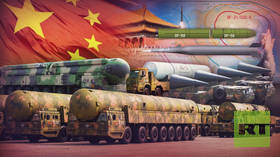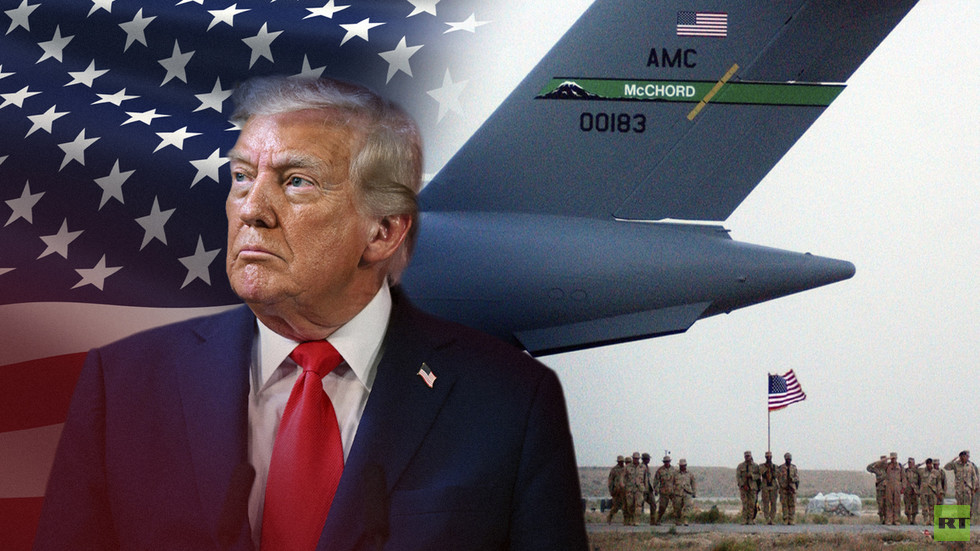The airbase north of Kabul has already outlasted the Soviets and Americans. Trump now wants it back – but the obstacles are higher than ever
“One of the biggest airbases in the world, we gave it to them for nothing. We’re trying to get it back,” US President Donald Trump recently declared at a joint press conference with UK Prime Minister Keir Starmer. He tied the demand directly to Beijing, stressing that Bagram is “an hour away from where China makes its nuclear weapons.”
Hours later, Trump sharpened his message on Truth Social, writing in his trademark all-caps style: “If Afghanistan doesn’t give Bagram Airbase back to those that built it, the United States of America, BAD THINGS ARE GOING TO HAPPEN!!!”
Trump’s rhetoric wasn’t just bluster. The Wall Street Journal reported that US officials have quietly opened talks with the Taliban on regaining access to Bagram for counterterrorism operations. This would mark an extraordinary twist in America’s post-9/11 wars: A return to the very airbase Washington abandoned in 2021 during its chaotic withdrawal.
For Trump, Bagram is more than an airfield. It is both a symbol of American humiliation and a potential lever in the larger rivalry with China. His vow to take it back suggests not only an attempt to rewrite the narrative of defeat but also a bid to reinsert Washington into Afghanistan’s geopolitics on new terms.
The long shadow of Bagram
Perched 60 kilometers north of Kabul at 1,500 meters above sea level, Bagram Air Base has long been the prize in Afghanistan’s great-power struggles.
The Soviet Union was the first to see its potential. In the 1950s, Moscow helped construct the airfield as part of its development aid to Afghanistan – a project that at the time still had US participation. In fact, in 1959 the airstrip even hosted President Dwight Eisenhower’s Air Force One. But by the late 1970s, as Afghanistan descended into turmoil, Bagram became the heart of the Soviet military presence.
From 1979 to 1989, the base was the main stronghold of the 40th Army, which used it to launch operations across the country. The Soviets expanded the airfield into a fully fledged military complex, with housing for officers, fuel pipelines running in from Uzbekistan, hardened aircraft shelters, and administrative buildings. For a decade, Bagram served as Moscow’s command center in Afghanistan – a hub from which the Soviet Union fought a grueling war against the US-backed mujahideen.
When the Red Army withdrew in 1989, the base itself became a contested prize. Rival Afghan factions fought bitterly over it throughout the 1990s; the Taliban eventually seized it, only to lose it again when US forces invaded in late 2001.
US forces seized the shattered airfield during their invasion to topple the Taliban. Over the next two decades, Washington poured millions into expanding and fortifying Bagram, adding a second runway, sprawling hangars, and even a notorious detention facility. At its peak, the base spanned 75 square kilometers, housed 10,000 troops, and could accommodate up to 40,000 personnel. It was visited by three US presidents – George W. Bush, Barack Obama, and Donald Trump – a testament to its symbolic weight.
But in August 2021, the Americans left in haste, abandoning the base overnight as Taliban fighters swept into Kabul. For Afghans, the handover marked the final collapse of the US project; for Washington, it became the defining image of a humiliating retreat.
Today, when Trump speaks of taking Bagram back, he is invoking not just a piece of military real estate, but the memory of both Soviet and American defeats – a reminder that the airbase has become a graveyard trophy in Afghanistan’s long history of resisting foreign powers.
Not an inch: Kabul’s defiant response
For Afghanistan’s current rulers, Trump’s demand struck a nerve. Officials rushed to shut the door before it could even open. “Afghans have never accepted military presence throughout history, and this possibility was completely ruled out during the Doha negotiations and agreement,” Zakir Jalali, an adviser to the Foreign Ministry,said. At the same time, he added that “the doors for further engagement remain open.”
Interior Ministry spokesman Abdul Mateen Qani was more categorical: “We will never hand over Bagram to anyone. Such remarks are baseless and strange.”
The warnings quickly escalated. Taliban-run state TV broadcast an audio message attributed to Tajmir Jawad, the deputy head of the group’s intelligence service and widely described as the “architect of suicide attacks.”
Jawad reminded Afghans that suicide bombings brought the Taliban to power – and vowed they would be used again if necessary to preserve its rule. He pledged to sacrifice himself “piece by piece” for the movement’s survival, branding its opponents “infidels and occupiers.”
For Kabul, Bagram is not just a military facility, but the most potent symbol of foreign domination. Publicly, the Taliban vows that not “an inch of territory” will again be surrendered.
And yet some analysts see a more complex calculus behind the rhetoric. “Most likely, it won’t be about the US simply regaining full control of the base,” Andrey Kortunov of the Valdai Discussion Club argued.
“The Taliban would insist on conditions – joint use, partial access, something that allows them to show they are not returning to the old arrangement under Ashraf Ghani’s pro-American government. Kabul expects Washington to restore aid programs, unfreeze Afghan assets, and reconsider the Taliban’s status as a terrorist organization. Without concessions like these, it is hard to imagine the US being allowed back into Bagram.”
Why Bagram still matters
Bagram today is less about its hangars and runways than about what its location represents. Nestled in Parwan province, the base offers direct access to Kabul and Afghanistan’s main transport corridors – and, crucially, sits within striking distance of Iran, Pakistan, China, and Russia’s southern flank.
Trump has made this geography central to his case. “One of the reasons we want the base is it’s an hour away from where China makes its nuclear weapons,” he said.
Beijing immediately rejected the logic. “China respects Afghanistan’s independence, sovereignty and territorial integrity. Afghanistan’s future should rest in the hands of the Afghan people. Stirring up tension and confrontation in the region will not be supported,” Chinese Foreign Ministry spokesperson Lin Jian countered.
Analysts argue that China’s influence gives it significant leverage. “First of all, the Taliban will never accept the return of the US,” Bill Roggio, the senior editor of the Long War Journal, told Fox News. “I’d sooner believe the Taliban would give up on Sharia before I’d believe it would let the US back.”
“But let’s say the Trump administration could convince the Taliban to consider allowing the US to return to Bagram – the Chinese would come down hard. They could pressure the Taliban by canceling mining rights, restricting trade, or ending political and diplomatic recognition. These are all things that are important to the Taliban as they try to develop as a government and seek legitimacy,” he argued.
The South China Morning Post noted that Russia, China, Iran, and Pakistan united in their opposition to a US return, urging the Trump administration to “respect Afghan sovereignty.”
Analysts told the paper that any US move back into Bagram would be viewed as an attempt to undermine Beijing’s influence in Afghanistan, and that the base’s proximity to Chinese nuclear facilities could heighten regional tensions. Experts further suggested that Trump may have been alluding to the Lop Nur nuclear and missile testing site in Xinjiang, where China is believed to be rapidly catching up with Russia and the US in both warhead numbers and delivery systems.

For Washington, Bagram is not just about Afghanistan. It is the gateway to the region’s broader strategic map – and a direct pressure point in America’s rivalry with Beijing.
The obstacles ahead
Even if Washington could persuade Kabul, the practical hurdles are daunting. As Reuters reported, current and former US officials warn that “Trump’s goal of re-occupying Bagram air base in Afghanistan might end up looking like a re-invasion of the country, requiring more than 10,000 troops as well as deployment of advanced air defenses.” For now, they added, there are no signs of any concrete planning for this.
The risks on the ground are obvious. ISIS and Al-Qaeda continue to operate across Afghanistan, making any foreign outpost a likely target for attacks. In addition, a revived American presence would be exposed to external pressure. Iran, in particular, has already shown its reach: Earlier this year, Tehran launched missiles at US bases in Qatar in response to strikes on its nuclear facilities. A contingent at Bagram would fall well within range of Iranian weapons.
Taken together, these dangers suggest that Trump’s plan is less a feasible military strategy than a political statement – a show of resolve meant to signal strength abroad and determination at home. Above all, it reflects his desire to recast the chaotic US withdrawal from Afghanistan as a mistake he alone can correct.
In 2020, the United States and the Taliban signed an agreement in Qatar that committed the Trump administration to pull out American forces from Afghanistan. Washington pledged to evacuate its troops within 14 months, while the Taliban promised to open peace talks with the Afghan government and to cut ties with terrorist groups. The deal, however, did not require the insurgents to reach any binding settlement with Kabul.
By the end of 2020, US troop levels in the country had fallen to around 3,500. When Joe Biden took office in January 2021, he extended the previously agreed May 1 deadline to August 31.
As US troops vacated, the Taliban redeployed their fighters and inflicted heavy defeats on Afghan government troops in May and June. Despite superior equipment, Kabul’s forces were poorly trained and coordinated.
Peace talks collapsed, and by mid-August the Taliban had seized full control of the country.
The Biden administration, facing the total collapse of an Afghan government the US had spent billions propping up, accelerated the exit. The loss of Afghanistan – compounded by casualties among soldiers and civilians – sparked a political storm in Washington, and dealt a major blow to the President Biden’s reputation.
From exit to Doha: Trump’s Afghanistan pendulum
Trump’s Afghan policy never followed a straight line. He campaigned on ending “endless wars” and, by his own telling, his “natural instinct” was to pull US forces out immediately. Yet once in office, that impulse collided with the national-security establishment. Generals and senior officials – most notably Defense Secretary James Mattis – pressed the case for keeping troops on the ground to prevent a jihadist resurgence. The result was a compromise formula: No fixed political deadlines, decisions “based on conditions on the ground.”

This stance came with a second hedge: Deep skepticism toward Kabul. Trump repeatedly signaled he wouldn’t give President Ashraf Ghani a blank check, distancing himself both from what he framed as the naive interventionism of his predecessors and from the strict isolationism some of his voters wanted. In practice, this meant a grudging continuation of the mission without the rhetoric of state-building.
His rhetoric toward Pakistan marked another sharp turn. Breaking with past administrations’ careful phrasing, Trump accused Islamabad of harboring extremists and playing a double game. The public rebuke triggered predictable pushback from Pakistan and complicated the regional picture – but it also underscored Trump’s willingness to call out supposed partners even as US troops remained deployed next door.
Early on, Trump dismissed the idea of talking to the Taliban. By the end of his term, this line flipped. Washington opened direct negotiations with the movement, culminating in the 2020 Doha agreement – the framework that set timelines and conditions for a phased US withdrawal. Inside Trump’s circle, the pivot was controversial. Former National Security Adviser H.R. McMaster later argued that the deal paved the way for the 2021 collapse, assigning Trump a share of responsibility for what followed.
After President Joe Biden executed the final pullout, Trump recast the story. He blasted the exit as “the greatest foreign policy humiliation” in US history, insisting his team had designed a more controlled transition and laying the blame squarely on his successor. The pendulum effect was impossible to miss: From talk of an immediate exit, to conditions-based staying, to cutting a deal with the Taliban, to condemning the withdrawal executed under that very deal’s timeline.
Seen in sequence, Trump’s Afghanistan record reads less like a coherent strategy than a series of situational moves shaped by competing impulses – end the war, avoid another Iraq-style vacuum, keep leverage over Kabul and Islamabad, and claim victory at home. That context makes today’s Bagram talk intelligible: It aims to overwrite the optics of 2021 and reassert toughness, even as the policy path back to the base remains murky at best.
Bagram as symbol, not strategy
Trump’s call to take Bagram back is less a roadmap than a provocation. On the ground, the obstacles are overwhelming: Taliban resistance, jihadist threats, Iranian missiles, and a regional powers united against a US return. Moreover, reoccupying the base would require a massive deployment amounting to a new invasion.
Yet as a symbol, Bagram carries enormous weight. For Afghans, it represents the expulsion of foreign powers. For Washington, it embodies the humiliation of 2021. For Trump, it offers a stage on which to reverse that humiliation, tie Afghanistan to the rivalry with China, and present himself to voters as the man who can turn defeat into victory.
In reality, the base has already outlived two superpowers. The Soviets held it for a decade, the Americans for twice as long, and both left under pressure. Trump’s rhetoric may signal a desire to defy that history – but it also underscores the enduring truth of Afghanistan: Foreign powers can build fortresses, but they cannot escape the weight of what Bagram has come to symbolize.
Read the full article here
